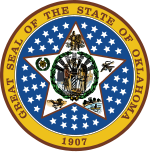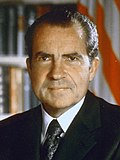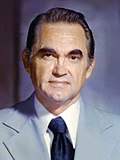| |||||||||||||||||||||||||||||||||
| |||||||||||||||||||||||||||||||||
 County Results
| |||||||||||||||||||||||||||||||||
| |||||||||||||||||||||||||||||||||
| Elections in Oklahoma |
|---|
 |
|
|
The 1968 United States presidential election in Oklahoma took place on November 5, 1968. All fifty states and the District of Columbia were part of the 1968 United States presidential election. Voters chose eight electors to the Electoral College, which selected the president and vice president of the United States.
Former Vice President Richard Nixon, the Republican nominee, won the state of Oklahoma with 449,697 votes and 47.68 percent of the vote, with Vice President Hubert Humphrey, the Democratic nominee, taking 301,658 votes and 31.99 percent of the vote, followed by American Independent George Wallace, who took 191,731 votes and 20.33 percent of the vote.[1] Nixon was the first Republican to ever carry Marshall County.
Wallace’s performance is the second-best by a third-party candidate in Oklahoma,[2] behind Ross Perot in 1992. Oklahoma was also Wallace's best performance in a state that had not been a part of the Confederacy. The Wallace pluralities in Atoka and Pushmataha Counties in the southeast marked the only occasion that a third-party candidate has ever carried any Oklahoma county.
Cite error: There are <ref group=lower-alpha> tags or {{efn}} templates on this page, but the references will not show without a {{reflist|group=lower-alpha}} template or {{notelist}} template (see the help page).
- ^ Dave Leip’s U.S. Election Atlas; 1968 Presidential General Election Results – Oklahoma
- ^ Thomas, G. Scott; The Pursuit of the White House: A Handbook of Presidential Election Statistics and History, p. 444 ISBN 0313257957


